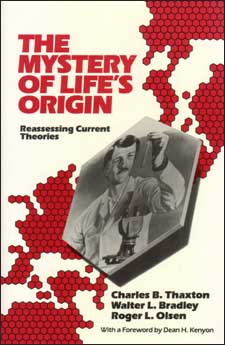 Intelligent Design
Intelligent Design
Essential Reading: The Mystery of Life’s Origin
[Editor’s Note: This is the first of a series of essential readings we’re highlighting in the evolution-ID debate]
The Mystery of Life’s Origin: Reassessing Current Theories
By Charles B. Thaxton, Walter L. Bradley, Roger L. Olsen
The Philosophical Library of New York, 1984, 228 pages
ISBN 0-929510-02-8
A seminal work for the theory of intelligent design, this book provides a scientific critique of the prevailing paradigmatic theories of chemical evolution. The authors include Discovery fellows Charles Thaxton and Walter Bradley, and they conclude that the prebiotic soup from which the first cell supposedly arose is a myth. The Miller-Urey experiments employed an unrealistic gas mixture, and there is no geological evidence for its existence in Earth’s distant past. The “soup” faces a myriad of other problems, such as inevitable rapid destruction at the hands of radiation.
The authors also take aim at the dominant paradigm for chemical evolution using technical arguments from thermodynamics. The second law of thermodynamics has been misused by creationists who failed to treat the fact that Earth is an open system. But Thaxton, Bradley, and Olsen takes this point into account as they argue that thermodynamics is eminently applicable to assessing whether unguided chemical reactions can organize matter into life. Their conclusion is that natural laws cannot account for the encoded “specified complexity” inherent in biomolecules.
The epilogue looks forward to other possible explanations for the origin of life. The book was published in 1984 when the United States was immersed in debate over Genesis-based creationism. Yet these authors take a different approach that is ahead of its time. They recognize that science requires an observation-based understanding of cause-and-effect relationships. Thus they set aside biblical arguments and focus instead on observations about the natural world and intelligence. After demonstrating that various undirected causes lack the power to produce complex information, they note, “We have observational evidence in the present that intelligent investigators can (and do) build contrivances to channel energy down nonrandom chemical pathways to bring about some complex chemical synthesis, even gene building” (pg. 211). The authors then pose a simple question: “May not the principle of uniformity suggest that DNA had an intelligent cause at the beginning?” (pg. 211)
